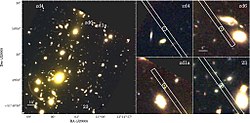| The topic of this article may not meet Misplaced Pages's notability guideline for astronomical objects. Please help to demonstrate the notability of the topic by citing reliable secondary sources that are independent of the topic and provide significant coverage of it beyond a mere trivial mention. If notability cannot be shown, the article is likely to be merged, redirected, or deleted. Find sources: "A1703 zD6" – news · newspapers · books · scholar · JSTOR (August 2019) (Learn how and when to remove this message) |
| A1703 zD6 | |
|---|---|
 A1703 zD6 (top right) A1703 zD6 (top right) | |
| Observation data (J2000 epoch) | |
| Constellation | Canes Venatici |
| Right ascension | 13 15 01.0068 |
| Declination | +51° 50′ 04.353″ |
| Redshift | 7.045 |
| Heliocentric radial velocity | 2,112,038 km/s (1,312,360 mi/s) |
| Galactocentric velocity | 2,112,133 km/s (1,312,419 mi/s) |
| Distance | 12.9 billion ly (4.0 billion pc) (light travel distance) 29 billion ly (8.9 billion pc) (comoving distance) |
| Apparent magnitude (V) | 25.8J |
| Other designations | |
| A1703-zD6 | |
A1703 zD6 is a strongly lensed Lyman-alpha emitter. It is located behind a foreground galaxy cluster known as Abell 1703, hence its name. It has a spectroscopically determined redshift of over 7, corresponding to a light travel time of 12.9 billion years. It is located in the Canes Venatici constellation. It was discovered in 2012, by a group led by L. D. Bradley, published in The Astrophysical Journal.
The C IV emission line (with a wavelength of 1548 Å) was detected from this galaxy, signifying triply ionized carbon. Because it takes high amounts of energy to triply ionize carbon, it may suggest that A1703 zD6 has an active galactic nucleus (AGN), or a population of very young, hot, and metal-poor stars. Subsequent investigations found that the ionization source is likely to be the latter: a cluster of stars (abbreviated SF, for star-forming region).
References
- ^ Bradley, L. D.; Bouwens, R. J.; Zitrin, A.; Smit, R.; Coe, D.; Ford, H. C.; Zheng, W.; Illingworth, G. D.; Benítez, N.; Broadhurst, T. J. (2012). "Through the looking glass: bright, highly magnified galaxy candidates at z ~ 7 behind A1703". The Astrophysical Journal. 747 (1): 3. arXiv:1104.2035. Bibcode:2012ApJ...747....3B. doi:10.1088/0004-637X/747/1/3. S2CID 118567077.
- Stark, Daniel P.; Walth, Gregory; Charlot, Stéphane; Clément, Benjamin; Feltre, Anna; Gutkin, Julia; Richard, Johan; Mainali, Ramesh; Robertson, Brant; Siana, Brian; Tang, Mengtao; Schenker, Matthew (2015). "Spectroscopic detection of C IV λ1548 in a galaxy at z = 7.045: Implications for the ionizing spectra of reionization-era galaxies". Monthly Notices of the Royal Astronomical Society. 454 (2): 1393. arXiv:1504.06881. Bibcode:2015MNRAS.454.1393S. doi:10.1093/mnras/stv1907.
- Dors, O. L.; Agarwal, B.; Hägele, G. F.; Cardaci, M. V.; Rydberg, Claes-Erik; Riffel, R. A.; Oliveira, A. S.; Krabbe, A. C. (2018). "Nature and chemical abundances of a sample of Lyman-α emitter objects at high redshift". Monthly Notices of the Royal Astronomical Society. 479 (2): 2294–2307. arXiv:1806.07732. Bibcode:2018MNRAS.479.2294D. doi:10.1093/mnras/sty1658.